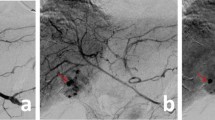Summary
To study the changes in intratumoral microvessel density (MVD) in hepatocellular carcinoma (HCC) following transcatheter arterial chemoembolization (TACE), MVD in 42 HCC specimens histologically verified was studied by using immunohistochemical method. Of all the specimens, 20 were obtained from the patients treated with surgical resection alone, 22 from those with second stage surgical resection after TACE. The results showed that the MVD in HCC tissues was 53. 4±21. 9 in the TACE group and 27. 6±9. 2 in the single operating group, respectively, with the difference being significant between them (P<0. 001). It was suggested that TACE might contribute to angiogenesis of HCC, possibly due to anoxic stress and ischemia-reperfusion injury.
Similar content being viewed by others
References
Araya M, Terashima M, Takagane Aet al. Microvessel count predicts metastasis and prognosis in patients with gastric cancer. J Surg Oncol, 1997, 65:232
Tanigawa N, Lu C, Mitsui Tet al. Quantitation of sinusoid-like vessels in hepatocellular carcinoma: its clinical and prognostic significance. Hepatology, 1997, 26:1216
Sun H C, Tang Z Y, Li X Met al. Microvessel density of hepatocellular carcinoma: its relationship with prognosis. J Cancer Res Clin Oncol, 1999, 125:419
1999,33(3):153
Kobayashi N, Ishii M, Ueno Yet al. Co-expression of Bcl-2 protein and vascular endothelial growth factor in hepatocellular carcinomas treated by chemoembolization. Liver, 1999, 19:25
Kim KM, Bae SK, Lee OHet al. Insulin-like growth factor I induced by hypoxia may contribute to angiogenesis of hepatocellular carcinoma. Cancer Res, 1998, 58: 348
Colletti L M, Remick D G, Burtch GDet al. Role of tumor necrosis factor-alpha in the pathophysiologic alterations after hepatic ischemia/reperfusion injury in the rat. J Clin Invest, 1990, 85:1936
Yamaguchi R, Yano H, Iemura Aet al. Expression of vascular endothelial growth factor in human hepatocellular carcinoma. Hepatology, 1998, 28:68
Prewett M, Huber J, Li Yet al. Antivascular endothelial growth factor receptor (fetal liver kinase 1) monoclonal antibody inhibits tumor angiogenesis and growth of several mouse and human tumors. Cancer Res, 1999, 59:5209
Drixler T A, Rinkes I H, Ritchie EDet al. Continuous administration of angiostatin inhibits accelerated growth of colorectal liver metastasis after partial hepatectomy. Cancer Res, 2000, 60:1761
Author information
Authors and Affiliations
Rights and permissions
About this article
Cite this article
Jilin, Y., Xiaofeng, L., Zhifang, Y. et al. Study on the changes in microvessel density in hepatocellular carcinoma following transcatheter arterial chemoembolization. Current Medical Science 21, 321–322 (2001). https://doi.org/10.1007/BF02886568
Received:
Published:
Issue Date:
DOI: https://doi.org/10.1007/BF02886568




